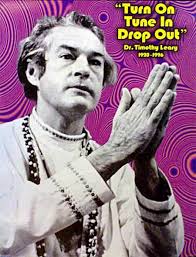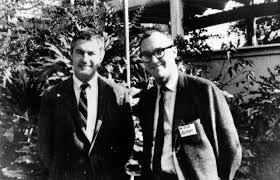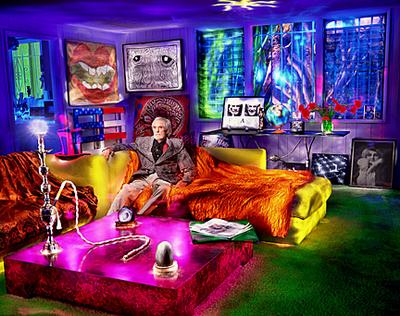 For a writer in modern-day Mexico, it seems a bit perverse to talk about those halycon days of the 1960s, when a great tidal wave of love and peace rose up on a sea of LSD. It is recalled as a more innocent time or, as Hunter S Thompson put it, in 'Fear and Loathing in Las Vegas',
For a writer in modern-day Mexico, it seems a bit perverse to talk about those halycon days of the 1960s, when a great tidal wave of love and peace rose up on a sea of LSD. It is recalled as a more innocent time or, as Hunter S Thompson put it, in 'Fear and Loathing in Las Vegas', There was madness in any direction, at any hour... You could strike sparks anywhere. There was a fantastic universal sense that whatever we were doing was right, that we were winning ....
And that, I think, was the handle—that sense of inevitable victory over the forces of Old and Evil. Not in any mean or military sense; we didn’t need that. Our energy would simply prevail. There was no point in fighting—on our side or theirs. We had all the momentum; we were riding the crest of a high and beautiful wave ....
The same novel name-checks Timothy Leary several times. He is the psychologist and Harvard lecturer cited with causing the whole Summer of Love. So what actually happened to him in Mexico to inspire this entire movement?
Dr Timothy Leary was born in Springfield, Massachusetts, USA. He spent some time in the army, stationed at West Point, before undertaking a degree in psychology at the University of Alabama. A Master's degree in the same was achieved, at Washington State University, before Leary moved on to gain his PhD at University of California, Berkeley. He stayed on at the latter, as a professor and director of psychiatric research; before transferring to Harvard University, as a lecturer in psychology.

It was while at Harvard that a colleague, Anthony Russo, invited Dr Leary to come on vacation to Cuernavaca, Mexico. Cuernavaca had long since been established as the 'Beverley Hills of Mexico'. It had been the vacation destination of choice for such Hollywood stars as Rita Haywood, as well as notorious American gangsters, like Al Capone. Then, as now, vacationers to the city could glimpse visiting royalty from all over the world. This was the location of Malcolm Lowry's seminal novel, 'Under the Volcano'. It was a Mecca for artists and writers everywhere.
On August 9th, 1960, Leary and Russo sat around a swimming pool, in their rented villa, Casa del Moros, downing shots of finest tequila. However, Russo had been here before and he had something else to share. He had first read of the religious rituals of the local Mazatec people, in a 1957 'Life' magazine article. The ceremony had included imbibing wild mushrooms, which caused visions. Russo's previous trip had involved seeking out these mushrooms and eating them himself. He wanted to do it again and asked Leary to accompany him.
They called upon Gerhardt Braun, from the University of Mexico, who had also encountered records of these mushrooms.
 As an historian, anthropologist and linguist, his findings had been academic. He had been translating ancient Aztec texts, when he'd read about their ceremonies. This also included the ritual use of the mushrooms, inducing mystic states, where the gods would speak directly to them. Braun knew from these texts where the mushrooms might be found, so set out to locate them in the modern day.
As an historian, anthropologist and linguist, his findings had been academic. He had been translating ancient Aztec texts, when he'd read about their ceremonies. This also included the ritual use of the mushrooms, inducing mystic states, where the gods would speak directly to them. Braun knew from these texts where the mushrooms might be found, so set out to locate them in the modern day. In the market town of San Pedro, he found an elderly lady, named Old Juana, who procured a bag of them for him. Braun raced back to the Cuernavaca villa, where Leary and Russo were staying. He gleefully invited the two academics to share his mushrooms with him. They both did so. Leary took the bowl and sniffed them, stating that they had the aroma of a New England basement, or a downed and rotting tree. He then ate seven of them, chasing away the bitter taste with some good Mexican beer. Leary recalled that he started "suddenly... to feel strange."
They hadn't quite realised how strong the mushroom trip would be. There six adults in all, sharing the villa, who had decided to participate in the quaint Mexican ritual. They all had children with them. Leary retained just enough wherewithal to call to a pregnant lady with them, who had declined the invitation to join them. He asked her to take the children out into Cuernavaca, to show them the sights or take them to the movies. She agreed to his request. A second sober adult stayed on to take notes. For those tripping, four hours passed in an instant.

Dr Leary was later to write that "it was the classic visionary voyage and I came back a changed man. You are never the same after you've had that one flash glimpse down the cellular time tunnel. You are never the same after you've had the veil drawn." He also declared that he'd learned more about psychology, during the 5 hours of the trip, than he had in 15 years of studying the subject as an academic. Leary took the mushrooms back with him to Harvard University and opened up a whole research department.
The studies included giving the mushrooms to 300 professors, graduate students, writers and philosophers, as well as 200 religious clerics. Leary wanted investigate the properties of the mushrooms, with a view to aiding alcoholics and reforming hardened criminals. It was initially a great success. 75% of those taking the mushrooms reported mystical visions and life-changing revelations. There were no ill effects on record. However, Leary then started giving the mushrooms to undergraduates and that brought him into conflict with the Harvard University administration.
What ensued was a rollercoaster ride through culture and counter-culture. As LSD, and the mushrooms, became illegal in America, in 1966, Dr Leary continued to preach the mystic properties of imbibing them. He lost his job at Harvard and spent time in trouble with the law. However, his status amongst the global hippy continguent elevated him into a hero, a legend and a prophet.
Throughout this time, Cuernavaca remained high in his esteem, as a place of pilgrimage. The start of it all. He returned several times, including immediately after being fired from Harvard University, and he set up a center of psychedelia there. The Summer of Love may have faded into legendary memory, but Cuernavaca is still popular with tourists. They are generally unaware of the city's association with Leary. They may come more for the cathedral and picturesque streets, but they come in their droves. It's a place for the rich kids of Mexico City to take some time out in the countryside. And for the hippies on the Timothy Leary trail, it's a place to look out 'with the right kind of eyes' and smile.


No comments:
Post a Comment